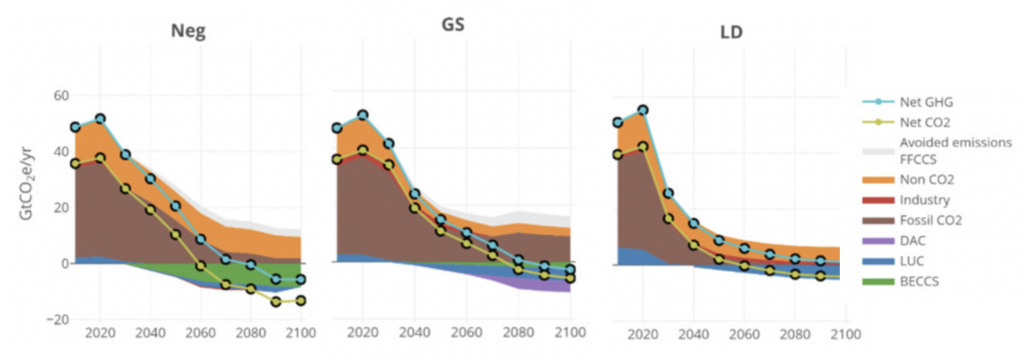Explainer: Why some countries are aiming for ‘net-negative’ emissions – Carbon Brief
[ad_1]
Last month, Germany became the first major economy to commit to a target to reach “net-negative” emissions later this century.
While “net-zero” describes a state where a country’s emissions are balanced by the amount of greenhouse gases it can remove from the atmosphere, “net-negative” describes a state of removals exceeding emissions.
Therefore, when a country achieves “net-negative” emissions, it has not only stopped its contribution to climate change, but is actively helping to reduce warming.
Many of the scenarios for achieving the world’s most ambitious climate goals require the world to become net-negative in the second half of this century.
In these scenarios, failure to cut emissions fast enough in the near term causes the world to “overshoot” its climate targets, meaning they can only be met later on in the century by removing billions of tonnes of carbon dioxide (CO2) from the atmosphere.
Some experts have also called on developed countries to aim to reach net-negative emissions earlier on this century, arguing they have a moral responsibility to reduce climate change and to create space for other countries to emit as they develop.
However, the ability of countries to remove CO2 from the atmosphere is defined by a range of factors, including their land area, forest cover and population size.
There is also a risk that setting distant net-negative targets could become a “distraction” from the urgent need to reduce emissions this decade, a researcher tells Carbon Brief.
Below, Carbon Brief explores which countries are or have targets to be net-negative, as well as the moral and scientific arguments for setting such a milestone.
What is meant by ‘net-negative’ emissions?
According to the Intergovernmental Panel on Climate Change (IPCC), “net-negative emissions” is achieved when human-caused greenhouse gas removals exceed human-caused greenhouse gas emissions.
The specification of “greenhouse gases” rather than CO2 ”makes a very big difference” when it comes to net-negative emissions, says Prof Joeri Rogelj, an IPCC lead author and climate scientist at Imperial College London.
The reason for this, he explains, is that there are some non-CO2 greenhouse gas emissions that will be almost impossible to eliminate completely. This is true even if the world makes every effort to meet the goals of the Paris Agreement, the global deal aimed at keeping temperatures well below 2C by the end of the century, with an ambition of keeping them below 1.5C.
This includes, for example, methane emissions from rice production. There are currently no technologies available to eliminate these emissions completely – and it is unrealistic to expect rice production to cease entirely in the future.
Scientists call these kinds of emissions “residual non-CO2 emissions”. Rogelj explains:
“Because of residual non-CO2 emissions, we will always reach net-zero CO2 emissions before we reach net-zero greenhouse gas emissions.”
To reach net-zero greenhouse gas emissions, some additional CO2 removal will be needed to compensate for impossible-to-eliminate non-CO2 emissions, he adds:
“To reach net-zero greenhouse gas emissions, we already need to reach net-negative CO2 emissions – because we know that non-CO2 emissions will always be an emissions contribution.”
Because of this, a national target to reach net-negative greenhouse gas emissions can always be interpreted as “significantly more ambitious” than a net-negative CO2 target over the same timescale, he adds.
Which countries are already at net-negative emissions?
Though the vast majority of countries are not close to being net-zero – let alone net-negative – there are a small number of global south countries that already remove more CO2 from the atmosphere than they emit each year.
This net-negative group includes Suriname in South America, Panama in Central America and Bhutan in south Asia.
Suriname is one of the most highly forested countries in the world. It has trees over 97% of its land surface.
Trees absorb CO2 as they grow and can store it in their leaves, trunks and roots. Tropical forests are particularly carbon dense, storing a quarter of all the world’s land carbon.
As well as being heavily forested, Suriname is also the smallest country in South America by population, with just 618,000 people.
Its low consumption combined with its ability to remove large amounts of CO2 through its forests each year has allowed Suriname to remain a net-negative country.
However, Suriname’s UN climate plan, known as its “nationally determined contribution” (NDC), says that “significant international support is needed” from developed countries in order for its forests to keep being protected.
In 2023, Reuters reported that Suriname has plans to sell forest carbon offset credits to developed nations under the Paris Agreement.
This means that Suriname wants to sell off some of its ability to remove CO2 from the atmosphere through its forests to more-polluting developed countries, who can then claim that they have effectively paid to reduce their own emissions.
Suriname argues this will bring in finance needed to protect its forests, Reuters said.
However, experts have questioned whether developed nations should be able to claim that they have reduced their own emissions by protecting Suriname’s forests. This is because these forests may have remained intact even without developed nations’ investment. If this were the case, it would mean that no real emissions reduction would have taken place.
(See Carbon Brief’s in-depth carbon offsets series to understand more about the accounting problems associated with forest carbon offset schemes.)
Much like Suriname, Bhutan in south Asia is characterised by high forest cover and a small population. It has trees covering 71% of its land, and 51% of its total land area is covered by strict laws ensuring forest cover is maintained.
At the COP26 climate summit in Glasgow in 2021, Bhutan started a “carbon-negative” club with Suriname as a founding member.

During the summit, Panama’s president declared that the country was also net-negative and that it would be joining the carbon-negative club.
According to Panama’s NDC, its emissions are currently more than balanced by its CO2 removals, which come largely from its forests. This is despite the country’s tree cover declining by 8.5% between 2000 and 2022.
The country has targets to restore 50,000 hectares of forest by 2050 and to cut its energy emissions by at least 24% by 2050, when compared to a business-as-usual baseline, according to its NDC.
At COP28 in Dubai in 2023, Panama also joined the Group of Negative Emitters, a small alliance of countries that are or are aiming to be net-negative led by Denmark (more on this below).
Aside from these three countries, there are other global south countries that claim to be “carbon sinks” in their NDCs – implying that they remove more CO2 than they emit each year.
This includes the heavily forested nations Gabon in Central Africa and Guyana in South America, as well as small island nations the Comoros, a volcanic archipelago off Africa’s east coast, and Niue, a south Pacific island.
The African island Madagascar has also claimed to be a carbon sink, but it is worth noting that the nation has lost 27% of its tree cover since 2001.
Which countries are aiming for net-negative emissions?
The past few years have seen a small number of global north countries commit to becoming net-negative on a variety of different timescales – and for a variety of different reasons.
Most recently in February 2024, Germany announced that it intends to introduce a target to reach net-negative greenhouse gas emissions by 2060.
In a document laying out the key features of its proposed target, the German government argues that reaching net-negative emissions, at least in some parts of the world, will be necessary to balance out unavoidable greenhouse gas emissions, such as methane from farming.
The government also says that, given the current pace of global emissions, limiting global temperature rise to 1.5C is looking “increasingly unlikely”.
It alludes to a situation in which the world first overshoots 1.5C and then uses CO2 removal techniques to bring temperatures back down, saying:
“Beyond carbon neutrality, net-negative emissions must therefore be used to reduce the greenhouse gas concentration in the atmosphere again in order to meet the 1.5C target and thus minimise the risks of serious and irreversible consequences for humans and ecosystems on Earth.”
(More on this below in: Does the world need to be net-negative to meet global climate goals?)
Back in 2022, both Denmark and Finland announced targets to reach net-negative emissions.
Finland announced targets to reach net-zero greenhouse gas emissions by 2035, and net-negative greenhouse gas emissions by 2040.
According to the climate not-for-profit Carbon Gap, Finland’s 2035 and 2040 goals represent the most ambitious legally-binding CO2 removal targets of any country globally.
Climate Home News reported that Finland’s targets were based on an analysis by the country’s independent climate panel. The analysis aimed to calculate what Finland’s “fair share” of global emissions should be, based on its share of the global population, its ability to pay to reduce emissions and its historic responsibility for causing climate change.
Finnish environment minister Emma Kari told Climate Home it was “very important” that the target was underpinned by research, adding:
“High income countries have to take a progressive and active role when it comes to tackling climate change.”
(More on this below in: Do some countries need to be net-negative to meet climate goals fairly?)
Denmark, meanwhile, announced targets to reach net-zero greenhouse gas emissions by 2045 and to cut greenhouse gas emissions by 110% by 2050, achieving net-negative emissions.
In a document explaining the rationale behind the new targets to the people of Denmark, the government said that the country has “an opportunity and an obligation to promote the spread of green solutions in the EU and globally”.
It said its new targets will “increase the implementation of already decided initiatives”, likely referring to the Paris Agreement.
At COP28 in December 2023, Denmark announced it was starting the Group of Negative Emitters, an alliance of countries that are at or are aiming for net-negative emissions. The group included Denmark, Finland and Panama.

However, it was neighbouring Sweden that was the first global north country to set a net-negative target.
Back in 2017, it committed to reaching net-zero greenhouse gas emissions by 2045 and net-negative emissions shortly after.
Reporting on Sweden’s climate law in 2017, New Scientist said it was the first country to significantly update its climate targets in light of the Paris Agreement.
One global north nation that has not yet set a net-negative target but has been advised to do so is Scotland.
Scotland has committed to reaching net-zero greenhouse gas emissions by 2045 – five years before the overall UK target of 2050.
The UK’s independent climate advisers, the Climate Change Committee (CCC), says that its central scenario for how the UK as a whole can reach its 2050 net-zero target sees Scotland becoming net-negative “well before” 2050.
Under this central scenario – known as the “balanced pathway” – Scotland reaches net-negative emissions sooner to compensate for slower action in Wales, England and Northern Ireland.
This reflects that Scotland has the largest remaining intact forests of any nation in the UK – and that Wales and Northern Ireland face a particularly steep challenge in reducing emissions in agriculture, the CCC says.
(Under the CCC’s most ambitious net-zero scenario – known as “tailwinds” – the UK as a whole reaches net-negative emissions shortly after 2042. The UK government has not indicated that it intends to act based on the CCC’s most ambitious scenario – and is currently behind on meeting its less ambitious targets.)
Another global north power that has been advised to set a net-negative target is the EU.
In advice published ahead of a recommendation for a new EU 2040 target in February, the bloc’s science advisers said that the EU could “improve the fairness” of its contribution to global climate action by adopting a net-negative target for “beyond 2050”.
EU members have not yet indicated that they are considering such a target.
Does the world need to be net-negative to meet global climate goals?
The question of whether, scientifically speaking, the world needs to reach net-negative greenhouse gas emissions in order to meet the Paris Agreement’s targets depends on what actions countries take in the next few years.
In its latest assessment of how the world can tackle climate change, the IPCC presents a range of scenarios for how the world can meet its temperature goals by the end of the century.
In some of these scenarios, global emissions fall extremely rapidly, avoiding the need for the world to reach net-negative greenhouse gas emissions.
However, because global emissions have remained so high in recent years, the path to limiting global warming to 1.5C or 2C is getting steeper and steeper, the IPCC says.
Many of its scenarios for keeping temperatures well below 2C by 2100 do rely on the world reaching net-negative greenhouse gas emissions in the second half of this century.
In these scenarios, failure to cut emissions fast enough in the next few years would see the world temporarily overshoot 1.5C. This is before large-scale CO2 removal techniques are rolled out globally, alongside ambitious measures to slash emissions, including rapid declines in fossil-fuel use.
At the point when greenhouse gas removals exceed emissions – when the world becomes net-negative – temperatures will be in decline and, depending on the scenario, may fall below 1.5C or 2C by the end of the century.
Summarising what the IPCC scenarios say about net-negative emissions, Rogelj says:
“Net-zero CO2 is a geophysical necessity, we need that to stop warming increasing. Net-zero greenhouse gases is more of a policy milestone. When we reach net-zero greenhouse gas emissions – let alone net-negative greenhouse gas emissions – global warming will be slowly reducing at the rate of a couple of tenths of a degree per century.”
Although many of the IPCC scenarios see the world turning net-negative this century, there are some scenarios where the world takes immediate action to rapidly cut emissions – meaning temperatures can be kept at 1.5C without large amounts of CO2 removal.
The charts below, adapted from the IPCC’s report on how to tackle climate change, illustrate how global greenhouse gas emissions change under various scenarios where temperatures are kept to 1.5C or well below 2C by 2100.
In the first scenario, “Neg”, temperatures are highly likely to overshoot 1.5C this century before returning to this level of warming by 2100. In this scenario, the extensive use of CO2 removal techniques sees the world reach net-negative greenhouse gas emissions (turquoise dotted line) by 2080.
(CO2 removal techniques include direct air capture (DAC – purple), land-use change such as tree planting (blue) and bioenergy with carbon capture and storage (BECCS – green). All of these methods are discussed in more detail below.)
In the second scenario, GS, there is a gradual strengthening of climate policies, giving the world a 66% chance of limiting warming to well below 2C by 2100. In this scenario, the world reaches net-negative greenhouse gas emissions around 2090.
In the third scenario, LD, a low demand for energy coupled with a rapid fossil fuel phaseout sees net greenhouse gas emissions drop to near – but not below – zero, limiting warming to below 1.5C without the world becoming net-negative.
(For a more thorough look at scenarios for keeping global warming below 1.5C or 2C, see Carbon Brief’s recently published interactive on the topic.)

Although almost all IPCC scenarios limiting warming to 1.5C – and most that stay below 2C – see a role for large-scale CO2 removal, the report also notes that the techniques available for doing this are at varying levels of readiness and pose different challenges and trade-offs.
Currently, tree-planting and ecosystem restoration are the only “widely deployed” forms of CO2 removal, according to the IPCC.
However, research suggests that relying too much on land-based CO2 removal methods, such as tree-planting and BECCS – a still emerging technique involving burning crops to produce energy before capturing the resultant CO2 – could take up large areas of land, threatening wildlife and food production.
DAC – which involves directly removing CO2 from air using giant fans that use chemical reactions to filter out the greenhouse gas – is currently limited by its large energy requirements and by cost, the IPCC says.
It is also worth noting that, while the IPCC sets out various scenarios for meeting the 1.5C and 2C targets, it does not map out the role that individual countries can or should play in meeting these goals.
Some argue that, given their wealth and historic responsibility for climate change, it is only fair that developed countries reach net-negative emissions in order to create space for ongoing emissions in developing nations. This is discussed in more detail below.
Do some countries need to be net-negative to meet climate goals fairly?
When setting its net-negative target, Finland made it clear that the rationale was to do its “fair share” when it comes to tackling climate change.
Under the Paris Agreement adopted by nearly every country in the world in 2015, it is officially recognised that developed nations should “take the lead” with slashing their emissions. Additionally, developed nations committed to providing financial assistance to help developing nations transition their economies.
This reflects the fact that developed nations hold the most historic responsibility for climate change. For example, the US and Europe have produced nearly half of all of the greenhouse gas emissions released into the atmosphere since the 1800s.
It also reflects the fact that developed nations have the most resources for addressing climate change.
It follows that developed nations should take the lead when it comes to reaching net-negative emissions, says Rogelj:
“Developed countries should decline emissions first and farthest. That also includes going net-negative, both CO2 and greenhouse gas emissions.”
Getting to net-negative emissions sooner could provide more room for developing nations to transition their economies while still prioritising development, he adds:
“When we think of the global pathway that needs to be achieved, the more ambitious that any country that is in a position to do so can be, the more leeway this provides for developing regions to pursue alternative paths.”
However, it is worth noting that not all countries will feasibly be able to go net-negative, he adds.
The ability of a country to go net-negative is defined by a variety of factors, including its land size, forest cover, economy and population size.
For example, heavily forested nations with relatively small populations will be more able to get to a position where they are removing more CO2 from the atmosphere than they are emitting each year.
Two out of three of the countries that are already at net-negative emissions, Bhutan and Suriname, are heavily forested with small populations.
Finland, which has the world’s most ambitious CO2 removal goals, has forests over nearly three-quarters of its land area.
Rogelj adds:
“I think countries that have CO2 removal potential should [set net-negative goals]. However, countries without CO2 removal potential, it’s useless to say you have to go net-negative.”
Prof David Reiner, a researcher of climate policy at the University of Cambridge, was part of a research effort to work out how the responsibility for CO2 removal could be shared equally between countries.
He says that trying to figure out who should be responsible for reaching net-negative greenhouse gas emissions is fraught with complicated questions, beyond which countries have the technical capacity. He tells Carbon Brief:
“It’s challenging to impose historical responsibility for climate change. We’ve seen in many areas, people chafe or resist what their grandparents might have done. One example is reparations for slavery. It becomes difficult to assign that. There are people here [in the UK] whose parents moved from the Indian subcontinent, whose emissions are they responsible for?”
He adds that there is a risk that more attention on setting net-negative targets could be a distraction from the urgent need for countries to reduce their emissions this decade:
“What I wouldn’t want to see is a rush for more and more countries to adopt net-negative targets to divert attention from the fact that they haven’t established how they’re going to get their net-zero targets. Or to say: ‘Well, now it’s even easier for us to justify missing our 2030 target, because look how tough our 2070 target is going to be.’”
Rogelj agrees that, while net-negative targets could have an important role to play in addressing climate change, there is a risk they could be a distraction unless coupled with more near-term action. He tells Carbon Brief:
“Any long-term target without a near-term plan is not credible.”
Sharelines from this story
[ad_2]


